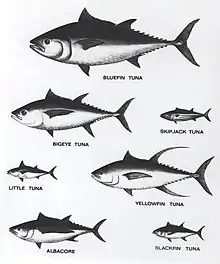鮪
| ||||||||
Translingual
Han character
鮪 (Kangxi radical 195, 魚+6, 17 strokes, cangjie input 弓火大月 (NFKB), four-corner 24327, composition ⿰魚有)
- kind of sturgeon,
Derived characters
- 𤃽
References
- KangXi: page 1469, character 21
- Dai Kanwa Jiten: character 46126
- Dae Jaweon: page 2002, character 18
- Hanyu Da Zidian (first edition): volume 7, page 4685, character 9
- Unihan data for U+9BAA
Chinese
| trad. | 鮪 | |
|---|---|---|
| simp. | 鲔 | |
Glyph origin
| Old Chinese | |
|---|---|
| 絠 | *kɯːʔ |
| 醢 | *qʰɯːʔ |
| 珛 | *qʰʷɯs |
| 栯 | *ɢʷɯʔ, *qʷɯ |
| 有 | *ɢʷɯʔ |
| 友 | *ɢʷɯʔ |
| 右 | *ɢʷɯʔ, *ɢʷɯs |
| 宥 | *ɢʷɯs |
| 囿 | *ɢʷɯs, *ɡʷɯ |
| 侑 | *ɢʷɯs |
| 酭 | *ɢʷɯs |
| 姷 | *ɢʷɯs |
| 又 | *ɢʷɯs |
| 佑 | *ɢʷɯs |
| 祐 | *ɢʷɯs |
| 賄 | *qʰʷɯːʔ |
| 蛕 | *qʰʷɯːʔ, *ɡʷɯː |
| 烠 | *ɡʷɯː |
| 倄 | *ɢraːw, *ɢʷɯːʔ |
| 鮪 | *ɢʷɯʔ |
| 洧 | *ɢʷɯʔ |
| 痏 | *ɢʷɯʔ |
| 郁 | *qʷɯ |
| 戫 | *qʷɯ |
| 哊 | *ɡʷɯ |
Pronunciation
Definitions
鮪
- Chinese paddlefish or Chinese swordfish; Psephurus gladius
- Synonym: 鱘/鲟 (xún)
- tuna
Compounds
|
|
|
Japanese
Kanji
(uncommon “Hyōgai” kanji)
- tuna
Readings
- Go-on: い (i)←ゐ (wi, historical)
- Kan-on: い (i)←ゐ (wi, historical)
- Kan’yō-on: ゆう (yū)←いう (iu, historical)
- Kun: まぐろ (maguro, 鮪); しび (shibi, 鮪)
Etymology 1
| Kanji in this term |
|---|
| 鮪 |
| まぐろ Hyōgaiji |
| kun’yomi |
Possible compounds include:
- 目 (ma, “eye, bound form”) + 黒 (kuro, “black”), in reference to their eye color.[1][2]
- 真 (ma, “true”) + 黒 (kuro, “black”), in reference to the color of their back.[1][2]
The kuro changes to guro as an instance of rendaku (連濁).
Pronunciation
- Kun’yomi
- (Tokyo) まぐろ [màgúró] (Heiban – [0])[3][4]
- IPA(key): [ma̠ɡɯ̟ᵝɾo̞]
Noun
鮪 • (maguro)
- a tuna (fish of the genusThunnus)
- マンガで分かるLisp (The Manga Guide to Lisp)
- みりん。地域猫。最近までマクロのことをマグロと思っていた。
- Mirin. Chiikineko. Saikin made makuro no koto o maguro to omotteita.
- Mirin: A neighbour cat. Until recently often confused macros with tuna [maguro].
- みりん。地域猫。最近までマクロのことをマグロと思っていた。
- Hypernym: 鯖 (saba)
- マンガで分かるLisp (The Manga Guide to Lisp)
- (colloquial) Short for 黒鮪 (kuromaguro): a Pacific bluefin tuna, Thunnus orientalis
- (slang) a dead fish (a sexual partner who lies flat during sex)
Usage notes
As with many terms that name organisms, this term is often spelled in katakana, especially in biological contexts (where katakana is customary), as マグロ.
Derived terms
- 鮪茶 (magucha)
- 磯鮪 (isomaguro)
- インド鮪 (Indo maguro)
- 梶木鮪, 旗魚鮪 (kajiki maguro)
- 黄肌鮪 (kihada maguro), 黄肌鮪 (kiwada maguro)
- 黒鮪 (kuromaguro)
- 五島鮪 (Gotō maguro)
- 塩鮪 (shiomaguro)
- 畜養鮪 (chikuyō maguro)
- 葱鮪 (negima)
- 畑鮪 (hatamaguro)
- 鬢長鮪 (binnaga maguro)
- 本鮪 (honmaguro)
- 南鮪 (minami maguro)
- めじ鮪 (mejimaguro)
Idioms
- 鮪を抱いて寝たよう (maguro o daite netayō)
See also
- 黄肌 (kihada, “yellowfin tuna”)
- 鬢長 (binnaga, “albacore”)
- 目撥 (mebachi)
- とろ (toro)
Etymology 2
| Kanji in this term |
|---|
| 鮪 |
| しび Hyōgaiji |
| kun’yomi |
⟨sibi1⟩ → */sibʲi/ → /ɕibi/
From Old Japanese.
(This etymology is missing or incomplete. Please add to it, or discuss it at the Etymology scriptorium.)
Noun
鮪 • (shibi)
- (obsolete) a tuna
- 711–712, Kojiki (poem 110)
- 意布袁余志斯毘都久阿麻余斯賀阿禮婆宇良胡本斯祁牟斯毘都久志毘 [Man'yōgana]
- 大魚よししび突く海人よ其が離ればうら恋ほしけむしび突く志毘 [Modern spelling]
- ouo yoshi shibi tsuku ama yo shi ga areba uragōshikemu shibi tsuku Shibi
- (please add an English translation of this example)
- Antonym: めじ (meji)
- 711–712, Kojiki (poem 110)
Derived terms
- 鮪節 (shibibushi)
- 糸鮪 (itoshibi)
- 蜻蛉鮪 (tonboshibi)
See also
- 大魚よし (ouo yoshi, pillow word alluding to shibi)
Etymology 3
| Kanji in this term |
|---|
| 鮪 |
| Hyōgaiji |
| irregular |
Appears in the Wakan Sansai Zue (1712).
(This etymology is missing or incomplete. Please add to it, or discuss it at the Etymology scriptorium.)
Noun
鮪 • (hatsu)
- (obsolete) a tuna
Derived terms
- 鮪の身 (hatsu no mi)
References
- Martin, Samuel E. (1987) The Japanese Language Through Time, New Haven, London: Yale University Press, →ISBN
- マグロ/鮪/まぐろ - Gogen Yurai Jiten (in Japanese)
- 2006, 大辞林 (Daijirin), Third Edition (in Japanese), Tōkyō: Sanseidō, →ISBN
- 1998, NHK日本語発音アクセント辞典 (NHK Japanese Pronunciation Accent Dictionary) (in Japanese), Tōkyō: NHK, →ISBN
Korean

Hanja
鮪 • (yu) (hangeul 유, revised yu, McCune–Reischauer yu, Yale yu)
- (다랑어) tuna, tunny
See also
- 참다랑어 (chamdarang'eo): tuna
- 참치 (chamchi): tuna